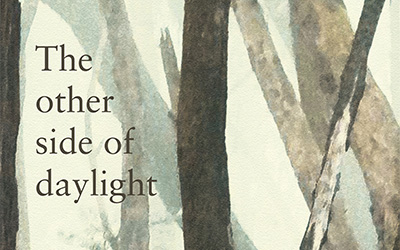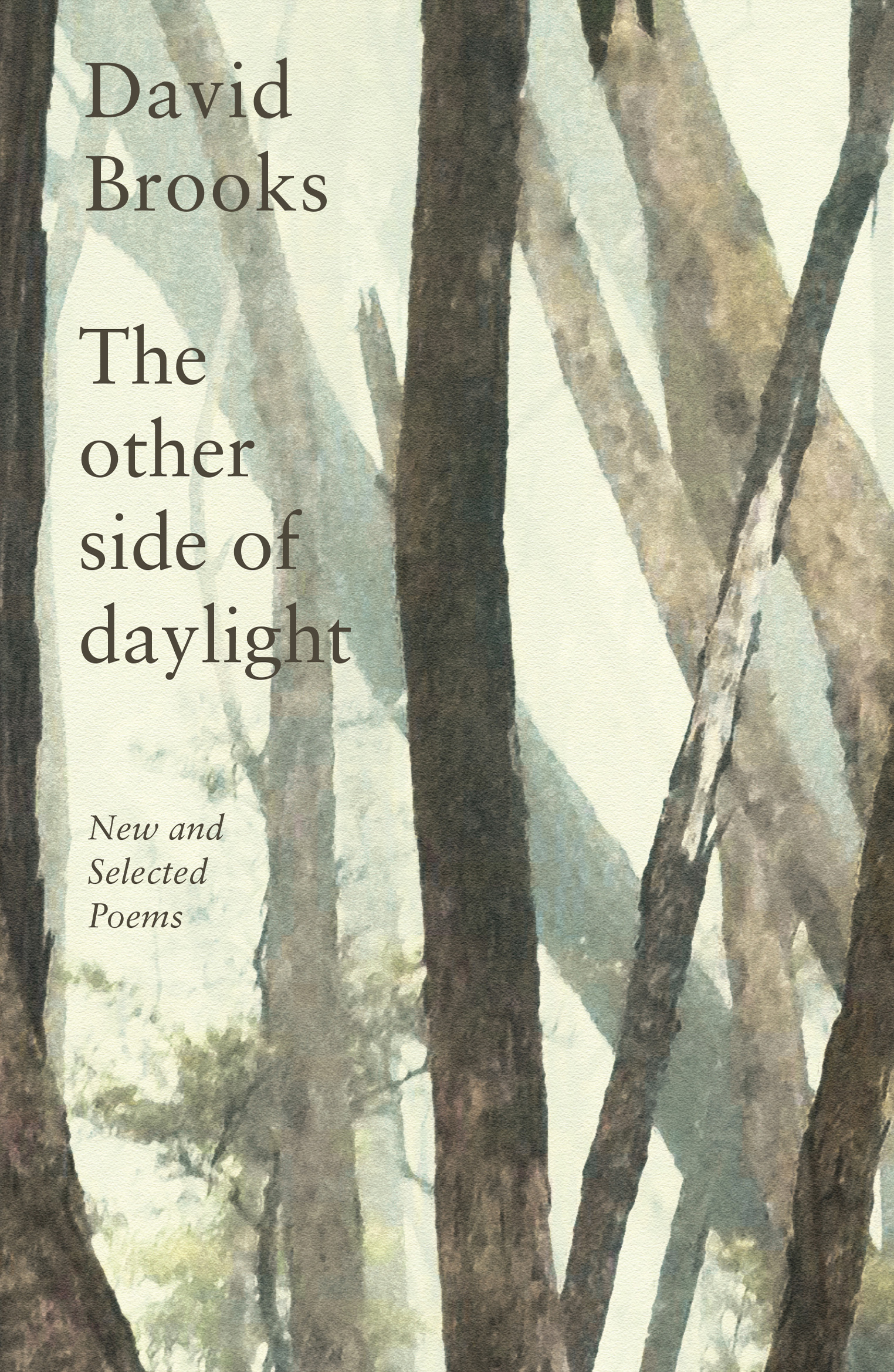
- Free Article: No
- Contents Category: Poetry
- Review Article: Yes
- Article Title: ‘Chill leaves the words’
- Article Subtitle: A masterly collection by David Brooks
- Online Only: No
- Custom Highlight Text:
The final poem of this superb collection, ‘The Darkness’, identifies a primal scene. The young protagonist is a nascent poet, watching over the embers of a desert fire in early morning, awaiting the breath of a Pentecostal wind to rekindle the flames. It is a parable which emblematises the difficult task of transformation that is central to poetry itself: the boy contends with ‘fragments / that will not alchemise to song / that yield not / to the metaphrast’.
- Featured Image (400px * 250px):

- Alt Tag (Featured Image): John Hawke reviews ‘The Other Side of Daylight: New and selected poems’ by David Brooks
- Book 1 Title: The Other Side of Daylight
- Book 1 Subtitle: New and selected poems
- Book 1 Biblio: University of Queensland Press, $26.99 pb, 206 pp
- Book 1 Cover Small (400 x 600):

- Book 1 Cover (800 x 1200):

The Deep Image poets with whom Brooks formed relations during his period in North America in the 1970s, such as Galway Kinnell and Mark Strand, were closely engaged in this Rilkean task. Kinnell’s most celebrated work, The Book of Nightmares (1971), is structurally modelled on the Duino Elegies, and the definition of poetry as the subjective transformation of the world of ‘Things’, delineated in the ‘Ninth Elegy’, is continually cited within Brooks’s writing practice. This also intersects with his interest in Chinese poetics (via Ezra Pound): as François Cheng asserts, in Chinese Poetic Writing (1982), ‘The man who possesses the void does away with the distance between things; the secret relationship that he finds among things is the same relationship that he has with things … he proceeds by “internal representation”.’ For the Deep Image poets, as for the post-surrealist poets gathered in Strand and Charles Simic’s anthology Another Republic (1976), the aspiration is towards a ‘mythological vision’ in which ‘the miraculous is always at hand, easily encountered if he [sic] pays attention’.
This overtly neoromantic poetics is very different from the Beat and New York School models prevalent within Australian postmodern poetry: the pseudo-shamanism of Kinnell’s most famous poem, ‘The Bear’, is directly satirised in John Tranter’s ‘The Anaglyph’. Brooks’s first volume, The Cold Front (1983), was distinctive in its influences, incorporating the minimalism of an Eastern European ‘poetry of austerity’, and most analogous to Strand’s The Late Hour (1978) in tone and cadence. Although appearing twenty years later, his second book, Walking to Point Clear (2005), is consistent with its vision: there is the same attentiveness to immanence within Nature, alert to ‘something else / gathering about us’, ‘something stirring’; and the Rilkean assertion of ‘my faith in Things’ is clearly stated in ‘Lemons’, in which the simplest objects provide passage to transcendence (for Brooks, as for Wallace Stevens, the motto is ‘Not Ideas about things but the Thing itself’). Yet these fleeting realisations are frequently countered by awareness of failures in language and in the speaker’s relations with the world: ‘a border / where chill leaves the words, / where even the fire leaves / and all that is said becomes hopeless’. The poet’s task is to overcome these negating forces, trusting that ‘Deeper still / there is a place where it begins again’ (‘Eschatologies’).
This theme of the difficulties of poetic transformation is resumed in Urban Elegies (2007), in which revelation is sought but never guaranteed: ‘as if you’ve had your chance at Pentecost / and blown it / and the golden tongues are gone’. Here poetry is depicted as both a Pentecostal ‘life’ force, and as the ‘mission’ demanded by Rilke in his ‘First Elegy’: ‘life / rising out of nowhere, / needing you for something – an errand – urgently’ (‘Golden Tongues’). In ‘Poem Beginning with Nothing’, the awareness that ‘losing is one of the patterns of being’ aligns with the obstacles to expression: ‘writing poems in a language that cannot do’. The potent revelation of poetic experience is explicitly stated in ‘Pentecost’, which describes a reading in which ‘[t]he pages turn, and on them are not sounds / but things’ – the audience receives a transformed vision of the world, made ‘to see again / our oldest, most familiar things / convinced that they have somehow changed’. The task of the ‘Ninth Elegy’ finds its fulfilment in these lines.
Fulfilment of another kind is attained in The Balcony (2008), in which Brooks invokes the ecstatic eroticism of Pablo Neruda’s The Captain’s Verses (1955) as a vitalistic counter to the ‘chill’ of loss that pervaded his earlier poems. In ‘The Cricket’, this is figured as a ‘mystical thunder-crystal of song’ that permeates all things with its life force. The Pentecostal energy set in motion by the near-death experience described in ‘The Quarry’ is now released: ‘tongue / loosened at last … it begins to / name itself or / tell me what it is’. This ‘loosening’ finds its expression in the full-throated polemics of poems such as ‘Pater Noster’, ‘Silent Night’, and ‘Passports’, in which issues of contemporary politics are vented in the manner of Lorca’s ‘New York (Office and Denunciation)’. Brooks’s increasing concern with issues of animal rights, evident in Open House (2015), is entirely consistent with his longstanding poetic practice of attention to the natural world. The theme of identification with the animal is the subject of poems such as ‘Rat Thesis’ and ‘Spiders About the House’ – the concluding image of the latter poem providing another rendition of the poet, ‘whose web’s his life itself’, attempting to repair damage within a ‘cocoon of words’. And ‘Each Other’s Tongue’, with its depiction of transformative union with the animal world, precisely encapsulates Rilke’s realisation of being ‘on the other side’.
In their later works, such as Kinnell’s Imperfect Thirst (1994), the Deep Image poets became increasingly prosaic and narratival. A consummate prose stylist, Brooks retains a firm commitment to poetic shape, and the new poems, gathered here as The Peanut Vendor (2016-23) demonstrate a widening of rhythmic range and attention to sound-patterning. ‘Stolen Lemons’ is presented with a Frostian simplicity of end- and half-rhymes. The satirical ‘Leaping Towards Boston’ employs a Murray-like springing rhythm to convey the movement of a kangaroo mob. In ‘The Forest Next Door’, evidently an elegy for Robert Adamson, Brooks displays a rhythmic motility that matches the dangerous energies of his subject. Once again, the centrality of the task of poetry itself is foregrounded: the shared experience is of ‘poetry with its dark insidious mysteries’, ‘the endless / Poem still caught in the teeth’.
The major works in this new selection are also elegies, though of a more tangential kind. In his earlier poem, ‘Captain Hunter and the Petrels’, Brooks writes: ‘A poem is a place where you can bring things together, you / don’t have to know why.’ This implies the relational approach of Pound’s ideogramic method and is wonderfully deployed in ‘Requiem’, which aligns cataclysmic bushfires, the death of a dog, the onset of Covid, and a granddaughter’s visit, patterned as relational images and events. Its companion poem, ‘The Magpie’, is another requiem of personal regret, juxtaposing the emanation of a ghostly visitor, and the intrusion of a ‘priest-like’ magpie, as synchronous ideograms to emphasise the shock of grief.
As Cheng writes, ‘A masterpiece is that which restores the secret relationship between things, and the breath that animates it as well.’ This masterly collection by one of our most important writers deserves to be celebrated.


Comments powered by CComment